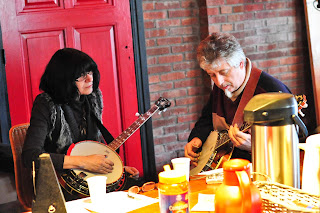Besides the conventional Scruggsrolls there are many other rolls you can play. Add some nice variations to your playing by stepping off the beaten path! But, I advise you strongly to become acquainted with the Scruggsstyle first, before you try these 'alternative' rolls. Keep in mind that the Scruggsstyle is a solid and very functional platform on which you can build other techniques. So practice your rolls and the licks that have made the fivestringbanjo famous in the world folk and beyond!
Playing a roll on three strings
Our first variation is based on a familiar roll: the forward-backward. This
roll is normally played on four strings: the third, second, first, fifth (which
creates the 'forwardmovement') and then the first, second, third and first
(creating a 'backwardmovement'). This variation has no fifth string. The roll
is played the same way as the conventional forward-backward, with the same
fingering positions for thumb-, index- and middlefinger. It’s not a difficult
to play variation; in fact, the fifth string has been left out and you’re
playing the third string as a substitute ( look at picture 1). This TFR (three
finger roll) can be used in a break, but is also very effective in backup.
Playing a roll on three strings
The same roll with a C- and D-chord.










